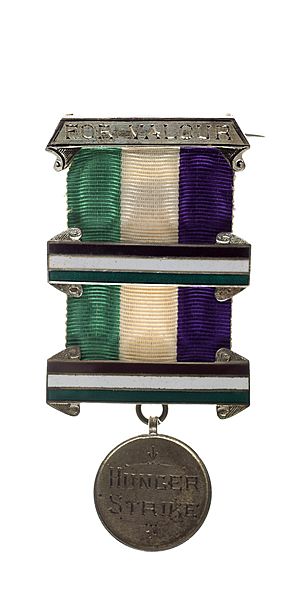Elsie Duval facts for kids
Quick facts for kids
Elsie Diederichs Duval
|
|
|---|---|
 |
|
| Born | 1892 |
| Died | 1919 |
| Other names | Eveline Dukes |
| Political party | Women's Party |
| Movement | Women's Social and Political Union |
| Spouse(s) |
|
| Relatives | Una Dugdale (sister-in-law) |
Elsie Diederichs Duval (1892–1919) was a brave British woman who fought for women's right to vote. She was part of the Women's Social and Political Union (WSPU). In 1913, she became the first woman released from prison under a special law called the 'Cat and Mouse Act'. Elsie passed away in 1919 from heart problems and pneumonia during a big flu outbreak.
Contents
Elsie Duval's Early Life
Elsie Duval was born in 1892. Her family strongly supported women getting the right to vote in the United Kingdom. Her mother, Emily Duval, was involved in the campaign many times. Elsie was one of six children, and her whole family worked for women's voting rights.
In 1907, Elsie joined the Woman's Social and Political Union (WSPU). She was too young for some of the group's actions at first. Later, she worked with the Men's Political Union for Women's Enfranchisement. Her brother, Victor Duval, started this group. Here, Elsie met her future husband, Hugh Franklin.
Fighting for Women's Votes
Elsie was not allowed to take part in some protests at first. But on November 23, 1911, she faced her first challenge. She was involved in a protest where the WSPU tried to give a petition to the Prime Minister. Elsie, her mother, two sisters, and brother Victor were all involved. After this, Elsie quickly volunteered for the next WSPU protest.
In July 1912, Elsie broke a window at a Post Office. She was sent to Holloway prison for one month. During her time there, she was given food against her will nine times. She was released on August 3.
The WSPU gave Elsie a special Hunger Strike Medal for her courage.
A few months later, on April 3, 1913, Elsie was involved in another incident. She was with Phyllis Brady (whose real name was Olive Beamish). They were carrying cases with materials that could start a fire. This was part of their protest actions. Both were sent to Holloway prison for six weeks.
While in prison, Elsie wrote a diary on toilet paper with a blue pencil. She described her difficult experiences. For example, she wrote about being given food against her will. She said, "pain at heart after."
The 'Cat and Mouse Act'
While Elsie and Phyllis were in Holloway, a new law was passed. It was called the 'Cat and Mouse Act'. This law allowed very ill prisoners to be released temporarily. The idea was to prevent them from dying in prison. Elsie became the first woman released under this act. She was supposed to return to prison after 14 days, but she did not.
Hugh warned Elsie that she and 'Phyllis' were being investigated. They were suspected of being involved in setting a house on fire. This fire caused a lot of damage. They were also thought to be involved in other fires. Because of these serious accusations, Elsie left the country and went to Europe.
Life in Europe
In Europe, Elsie used a different name, Eveline Dukes. She had fake references to help her find jobs in different countries. She worked as a governess in Germany for 10 months. Then she spent three months in Brussels learning French and doing office work. After that, she spent two months in Switzerland.
Elsie hoped to travel with Hugh, but a friend warned against it. In March 1914, she received a letter from Jessie Kenney. The letter suggested Elsie should stay where she was until she felt stronger. When World War One started in 1914, Elsie returned to the UK. This was because a general pardon was given to many suffragettes.
Love and Marriage
Elsie and Hugh became engaged in March 1913. Elsie felt that the 'Cat and Mouse Act' made their plans difficult. Even though they went to France together, they traveled separately through Europe.
When Elsie returned in 1914, she continued her political work. She supported the WSPU in the following years. But she also found more time for her personal life. In June 1915, she invited Emmeline Pankhurst to be a witness at her wedding. However, Mrs. Pankhurst was away at that time. Elsie and Hugh got married at West London Synagogue on September 28, 1915. Their marriage was short, as Elsie passed away just over three years later.
Elsie's Final Years
In 1917, Elsie joined the new Women's Party. This party was started by Christabel and Emmeline Pankhurst. Elsie continued to campaign for women's right to vote. Finally, in 1918, the Representation of the People Act was passed. This law gave some women the right to vote for the first time.
In 1919, Elsie died at the age of 26. Her health was affected by her experiences in prison. She also had heart problems caused by septic pneumonia. She caught this during the 1918 influenza epidemic. In her last letter to Hugh, she wrote, "my heart is like a steam engine." It is believed that her past experiences severely impacted her health.




